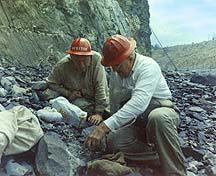Jeffrey Quarry
Current Status: closed, no admission to property
 The Jeffrey Quarry, located in North Little Rock, AR, was the site of the discovery of solution quartz. The photo on the left shows geologists Dr. Charles Milton (left) and Hugh Miser investigating the floor of the quarry in the 1960's.
The Jeffrey Quarry, located in North Little Rock, AR, was the site of the discovery of solution quartz. The photo on the left shows geologists Dr. Charles Milton (left) and Hugh Miser investigating the floor of the quarry in the 1960's.
When first discovered, some collectors were certain the quartz was still growing in the original clay host, rectorite. But crystal growth at that time was impossible because the temperature was too cool and the original formational water had been flushed from the system.
Above, 3 small Jeffrey floater clusters, or burrs, and 2 single double terminated crystals. This is the type of crystal that got many collectors excited when this site was open. The burrs formed in pockets of rectorite as many single crystals grew and interlocked together. Literally, millions of needle crystals were recovered from zones of vaseline-like rectorite-filled vugs in fractured quartz veins over the 15-year period that the site was accessible. Thousands of small clusters were available. The best quality clusters from this site were open, highly lustrous groups of transparent colorless crystals. Because slightly milky crystals were more typical, less common gemmy transparent burrs are most highly valued.
The way it used to be
During the active life of the quarry, many people got to collect on weekends by paying the security guard. When construction of US Interstate 40 ended, the quarry became inactive. During the time that the quarry was slowly filling with water, collectors had access pretty much anytime.
In about 1975, two geology students from Fayetteville, who were commercial mineral collectors, leased the quarry and drained the small western pit, drilling, blasting, and hand-digging solution quartz from as many veins as they could find. Meredith York and Gene Newsom sold much of what they collected to several dealers, but they retained the best material for their personal collections.
After the small pit again filled with water, Gene continued to have a working relationship with the quarry owners, Nabholtz Construction Company of Conway, AR, until the late 1980's when the situation changed. The company, for a few summers during the late 1980's, leased the quarry to some local people, who charged a fee to go swimming there, but after 2 drownings in 2 years the company ended that arrangement. It was leased for a summer by one of the local scuba diving businesses as a training site.
Since that time, the quarry has been considered an attractive nuisance as the site is somewhat isolated and has several access roads. It became a very popular place for drug dealers and complaints from neighbors of frequent gunshots resulted in frequent patrols by local police and county sheriffs.
So we must, for the time being, consider the site as closed and inaccessible.
It is the loss of such prolific specimen-producing sites as this one in Arkansas that makes many a collector believe the statement that the glory days of collecting are long gone. I am certain that there are individuals who have tremendous amounts of quartz from this site hoarded away. Unfortunately for new collectors, the hoarders usually have to die and their relatives, who have no interest, give the stuff away to a neighbor or, worse yet, toss it out.
Check the literature
Two articles have been written for the collector about this site. The earliest was in 1964 while the quarry was still active. It is Arkansas Geological Commission Bulletin 21 - Quartz, rectorite, and cookeite from the Jeffrey quarry, near North Little Rock, Arkansas by Miser and Milton. It is still available from the AGC for a nominal charge. The second was an article with excellent photographs in the Mineralogical Record, The Jeffrey Quarry by Gene Newsom, 1978, v. 9, no. 2, p. 75-79.
You can still buy crystals
Today I often see Jeffrey quartz specimens for sale by locals which would have been thrown away during the heyday years of collecting. Even single needle quartz may sell for from $15 to $300 per pound depending on how select and large the needle crystals are. Many jewelry folks want these now.
I even heard from one collector that an individual came and paid him to "mine" the needle crystal from his back yard where he had washed Jeffrey specimens for years. Later that year, I saw the result of the "miner's" efforts when I saw a lot of perky boxes of little Jeffrey quartz clusters in several local rockshops and tourist shops in the Hot Springs area. But they weren't clusters. On close inspection, the fellow had used colorless clear jeweler's cement to glue the little singles into clusters for tourists!! I guess necessity is the mother of invention!
It is rare, but occasionally at Tucson, or some local shows here in Arkansas, you may find really nice specimens for sale. The prices are high, but just a small percentage of everything collectors hauled away was really top quality. In my opinion, the best crystal ever to come from this site has several common characteristics: water clear; open interlocked clusters and haystacks (haystacks have no attachment point, they formed as free-floaters in the veins); brilliant luster; and combined with any of several other minerals (cookeite, ankerite, fluorapatite). Some spectacular platey haystack masses of quartz reached 1 foot by 9 inches by two inches in thickness!
Granular cookeite on quartz from Jeffrey quarry
Ankerite on multiple-terminated single quartz crystals, Jeffrey Quarry
Double-terminated with faden (string) near parallel to c crystallographic axis
Multiple terminated parallel growth with faden (string)
A fantastic collection of Jeffrey quartz and associated minerals, the life long collection of Gene Newsom, is now available for public viewing at the Arkansas Geological Survey, thanks to the generosity of Philip Newsom, Gene's brother.